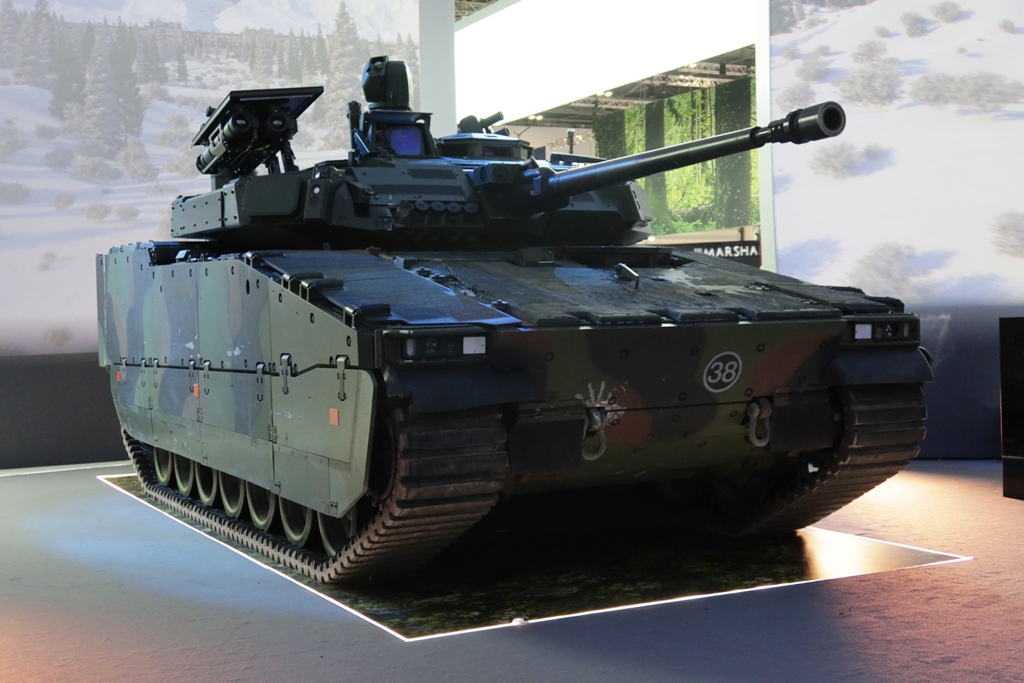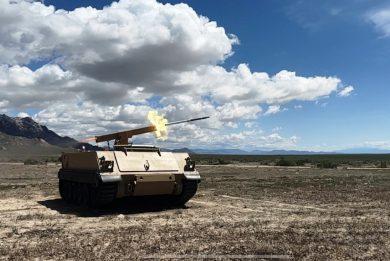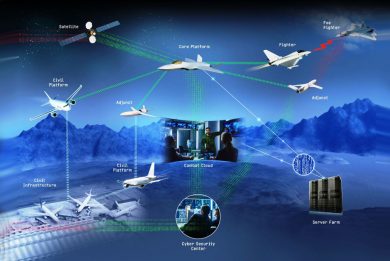
DSEI 2025 – BAE Systems Hägglunds, increasing production capabilities with an eye to the future
With around 600 CV90s and a similar number of BvS10s on its order book, BAE Systems Hägglunds plant in Örnsköldsvik, northern Sweden, is producing at maximum pace, work to further increase its capacity being ongoing
At DSEI 2023 EDR On-Line interviewed Tommy Gustafsson-Rask, the BAE Systems Hägglunds President, the production increase issue being the core of the talk. Two years later the subject is still hot, production capacity increase being a tough issue, as it includes facilities, manpower and subcontractors. How much the Swedish branch of BAE Systems managed to hit its intended targets?
“I would say that compared to the targets set two years ago we are in the midst of our production capacity increase,” the company President states, without mentioning any precise number. “We will be reaching full strength during 2026. But since we talked last time, the world is changing rapidly and the need of the systems we produce is increasing,” he underlines. “Firstly, we are optimizing the investments we have done; however we are also considering some add-on investment to further increase our capacity,” Tommy Gustafsson-Rask unveils.
The Örnsköldsvik facility is busy on many programmes. “For the moment, we have CV90 upgrades ongoing for Finland and Switzerland, those programmes nearing the end. We have ongoing activities with Sweden, as we are rebuilding some of the old vehicles into new variants. And then we have the Dutch mid-life upgrade programme ongoing, where we are basically building new turrets. Then on the increasing capacity to deliver a complete CV90, we are starting to set up production capacity in both the Czech and Slovak republics,” he explains. Increasing production cannot be done in real time. “Customers would probably like us to move faster, but we have been going as fast as we possibly could,” the President says.
To be able to increase production the OEM does not deal only with in-house capacity, but it must also take into consideration subcontractors production volumes. “I think the supply chain is ramping up well. If you look at the main components, such as guns, engines, transmissions, tracks, and things like that, what is produced by so-called A Level suppliers, these are following our pace, they are heavily integrated into the system, and they have ramped up to meet our needs so far. There have been some issues, but we have been solving them one by one. The challenge is in smaller articles, like cabling, headlights, hydraulic pumps and so on, which were traditionally single sourced. We are now working a lot on double sourcing, and we might probably see some triple sourcing as well,” Tommy Gustafsson-Rask says, adding that the supply chain is still something that needs to be monitored and BAE Systems Hägglunds is working very proactively with subcontractors to be able to hold on deliveries. EDR On-Line understood that turrets structures, as well as cabling and other subsystems are considered B Level components, mostly designed by the OEM, which maintains the intellectual property, and are manufactured by third parties. Then come C Level components which are COTS or MOTS acquired from subcontractors.
Having multiple subcontractors for some CV90 components might not only help to solve volume production issues, but also to improve the national content in some of the customers countries. “We are using this opportunity, especially in the start-up position, and we currently have ongoing activities in four countries. When the Six Nations agreement [1] will become reality, we will be able to do that even more.”
Production wise, setting up assembly lines in some customer’s countries, namely the Czech and Slovak republics, considerably helps reducing the strain on the Örnsköldsvik facility. “If I should do all the production in Sweden, I had to multiply investments by three, but now I have investments done in earlier programmes that I can use,” Tommy Gustafsson-Rask points out, underlining that having been successful on the export market is a major factor in dealing with the production spike.
In late May 2023 BAE Systems Hägglunds was awarded a US$ 2.2 billion contract by the Czech Republic for delivering 246 CV90 Mk IV in seven different variants. Thirty-nine of those will be produced in Sweden, and the first infantry fighting vehicle was rolled-out on August 29th at the Örnsköldsvik plant. “We will assemble here 10 CV90s, which will allow us to verify drawings and to be sure that all is working properly. Then, the only assembly that will come from Sweden will be the chassis hull, while all the rest will be manufactured or assembled locally,” the company President explains. Twenty-nine more CV90s will be fully produced at the Örnsköldsvik plant. “These will be turretless variants that require the integration of complex systems, namely the recovery and the engineer variants, which will be produced in small numbers that do not justify a delocalised production,” EDR On-Line was told, while the remaining 207 CV90s, most of them in the IFV configuration and some in four more variants, command and control, reconnaissance, mortar, and MEDEVAC vehicles, will be produced in the Czeck Republic.
The production for the Slovak Republic will follow the same scheme. The US$ 1.37 billion contract for 152 CV9035 IFVs was signed in December 2022, earlier than that with the Czech Republic, however the first vehicle will be rolled out in the coming months, before the end of 2025. Here too the majority, 122, will be in the IFV version, 12 more in a specific Anti-Material Rifles/Grenade Launcher Squad configuration, the remaining in command and control, reconnaissance, engineer, and recovery variants, the latter two to be entirely produced in Sweden. Overall 133 CV90s will come out of the Slovak assembly line.
EDR On-Line understood that serial turret production has already started both in the Czech and the Slovak republics. “The two contracts are basically proceeding in parallel, and both countries will start receiving their first vehicles in 2026,” Tommy Gustafsson-Rask says, adding that serial delivery will commence in 2027, both nations having a commitment to provide operational brigades to the Atlantic Alliance by 2030.
In past interviews it was made clear that the Mk IV will be the latest iteration of the CV90. Technology is however continuously evolving and BAE Systems Hägglunds is endlessly adding elements to improve its combat vehicles capabilities.
“Several technology insertions are being included in the CV90 Mk IV, but we haven’t talked much about them. Starting from the reconnaissance variant of the CV90 Mk III, this is fitted with a telescopic mast carrying a sensors suite, on which the customer is fairly secretive. Both Czech and Slovak contracts include reconnaissance variants that comprise advanced sensors,” the company President tells EDR On-Line without mentioning artificial intelligence, which should however be at the core of some capacities. “If you look at the Mk IV and the Mk IIIC for example, the commander sight contains an algorithm that allows the operator to work in standard target detection mode, but it can also switch it to a drone auto-search mode, which gives the vehicle commander an alert when a drone is approaching. The vehicle becomes therefore part of a layered drone defence, the airburst munition capability of the main gun becoming the effector,” Tommy Gustafsson-Rask explains.
The hard-kill capacity might be preceded by a soft-kill option, adding specific jammers to the vehicle. “I think there will be a continuous evolution of how to use all the sensors, how to stitch them together, to get a better situational awareness. Drones themselves may help, and we already integrated small reconnaissance drones on CV90s for two customers; there are two of them on the vehicle, so one is constantly airborne, while the second recharges its batteries. We also did studies on tethered drones, that would fly at height over the vehicle. From my standpoint this is no revolution, it is a continuous evolution, it’s a spiral that will never end, and this is probably something we learned from the war in Ukraine, where things change weekly.” Apart from some sensors, which acquisition is regulated by strict rules, most of these capacities become part of the CV90 menu that BAE Systems Hägglunds can propose to new customers, as well as to existing customers who want to increase and/or upgrade their fleets.
Among those we can definitely count the aforementioned Six Nations that last June signed the Statement of Intent. “Sweden is the lead nation, and signed the agreement with Norway, Finland, Lithuania, Estonia and the Netherlands at ministerial level aiming at a joint procurement. Discussions are ongoing with all the nations, we don’t have any number of vehicles yet, but we will talk of several hundreds, this my assessment, the objective being to come to a contract during 2026,” EDR On-Line understanding that harmonising requirements is currently the main issue.
“We have done a specification on the CV90 Mk IV, and this is our proposal for a base vehicle. Workshops were then carried out with the nations, and I think we are going to come further than I expected in terms of commonality. If some of the countries agree, then the remaining ones have the alternative of joining or do another procurement. And I think that Army chiefs are very much looking forward to high commonality, which will mean that the vehicles will not be only interoperable, they will be interchangeable, which will allow having common training and logistics,” we were told, understanding that commonality should be in the 95-98% range, the few elements still national being mostly in the C4 domain.
While the CV90 continues to be the most widely diffused west European infantry fighting vehicle, in Örnsköldsvik part of the company R&D team is working on the future. “Development activities are ongoing all the time,” states Tommy Gustafsson-Rask.
[1] In June 2025 Finland, Sweden, Norway, Lithuania, Estonia, and the Netherlands have signed a statement of intent to explore a joint procurement of CV90 armoured infantry fighting vehicles from BAE Systems Hägglunds.
Photo by P. Valpolini



